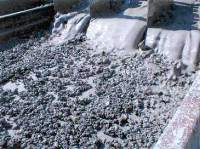ITALY: An inhibitor system for drilling reactive clays
April 2001 Vol. 222 No. 4 Feature Article ITALY: An inhibitor system for drilling reactive clays Fulberto D’Alessandro, AVA S.p.A This case study
ITALY:An inhibitor system for drilling reactive claysFulberto D’Alessandro, AVA S.p.A This case study refers to the drilling of a highly deviated well located in the Adriatic foredeep in September 2000. TD was 10,432 ft (3,200 m). The main problems were related to drilling reactive clay of Pliocene age, with possible occurrence of borehole instability and low inhibition of cuttings. It details the performance of a new product for a water-based mud system designed to drill these highly reactive clays. Testing the cuttings showed a cationic exchange capacity of 25 to 35 meq/l. The most suitable drilling fluid would have been oil-based mud (OBM), because it does not react with the formation, although it requires expensive hauling and treatment of wastes.
Objectives. The operator’s objectives were: to minimize drilling costs in compliance with environmental constraints, thus reducing dilution volumes and related costs (new mud, transport and disposal); and to save time avoiding hole-instability problems (bit balling, tight hole and clay plugs). To reach these goals, Italy’s AVA proposed a new product, Avapolysil, mixed with potassium carbonate. The new product is a balanced blend of silicate and organic compounds. The soluble silicate invades shale and readily reacts with available polyvalent ions in the shale pore fluid (mainly Ca2 and Mg2) to form insoluble precipitates. Moreover, the neutral-to-acidic pH of pore fluids can trigger silicate gellation, thus providing a further barrier against shale swelling. Organic compounds increase filtrate viscosity, reducing filtrate invasion. The combination with potassium carbonate provides a strong K+ ion source that increases osmotic pressure, effectively dehydrating shale. The system does not include polluting compounds. Concentrations during drilling were as follows: Avapolysil – 10.5 to 12.25 lb/bbl, potassium carbonate – 2.25 to 14 lb/bbl. Results. Drilling operations were performed in 55 days vs. 65 programed. Total drilling hours were 426, with a resulting average rate of penetration of 8 m/h (26 ft/hr) and peak values of 20 m/h (72 ft/hr). During drilling, no problems due to mud or hole instability were reported. The dilution rate was as low as 2.57. Results clearly showed the effectiveness of the new
product, plus potassium carbonate, system. The system, used for the first time in Italy to drill very reactive
clay formations, gave performances similar to those of an OBM at $1,192/m3, but at lower costs and
reasonable environmental impact, i.e., Avopolysil + K2CO3 = $246/m3.
|
- Applying ultra-deep LWD resistivity technology successfully in a SAGD operation (May 2019)
- Adoption of wireless intelligent completions advances (May 2019)
- Majors double down as takeaway crunch eases (April 2019)
- What’s new in well logging and formation evaluation (April 2019)
- Qualification of a 20,000-psi subsea BOP: A collaborative approach (February 2019)
- ConocoPhillips’ Greg Leveille sees rapid trajectory of technical advancement continuing (February 2019)



